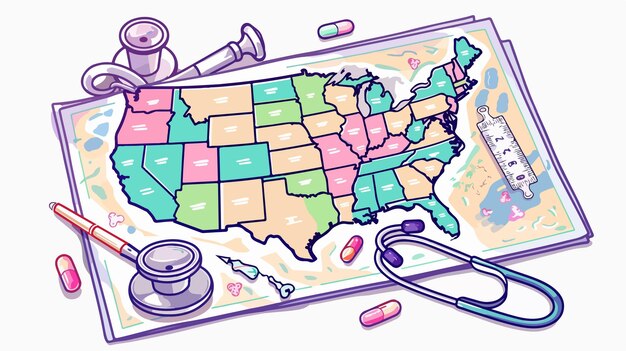Family Travel Safety: 5 Essential Tips for US Explorers

Family travel safety encompasses essential precautions to protect children while exploring the US, focusing on pre-trip planning, health safeguards, emergency preparedness, digital security, and creating kid-friendly itineraries for a secure and enjoyable experience.
Embarking on a family adventure across the US promises unforgettable memories, but prioritizing family travel safety: 5 essential tips to protect your children while exploring the US is paramount to ensure a smooth and secure journey.
Planning and Preparation: Your First Line of Defense
Before you even pack your bags, meticulous planning sets the stage for a safe and enjoyable family trip. Consider these preparatory steps to minimize potential risks and ensure everyone is well-prepared.
Research Your Destinations
Understanding the specific challenges and opportunities presented by each destination is crucial. From weather patterns to local customs, knowledge is power.
Delve into the details of each stop on your itinerary. Check for travel advisories, understand local laws, and research potential health risks. Being informed will empower you to make smart decisions on the ground.
Pack a Comprehensive First-Aid Kit
Minor injuries and ailments are common during travel, and having a well-stocked first-aid kit can prevent a small inconvenience from becoming a major problem.
- Include essentials like bandages, antiseptic wipes, pain relievers, and any prescription medications your family members require.
- Consider adding items specific to your destination, such as insect repellent for mosquito-prone areas or sunscreen for sunny climates.
- Keep your kit easily accessible and ensure everyone knows where it is located.

Create a Detailed Itinerary and Share It
A well-defined itinerary not only helps you stay on track but also provides a crucial safety net. Share your plans with family or friends back home so they know your whereabouts.
Include flight details, accommodation information, and planned activities. This information can be invaluable in case of emergency.
In conclusion planning and preparation are the cornerstones of safe family travel, so spend ample time researching your destinations, packing a comprehensive first-aid kit, and creating a detailed itinerary to minimize risks and maximize peace of mind.
Health and Wellness on the Road: Staying Fit and Safe
Maintaining your family’s health while traveling is essential to prevent illness and ensure everyone can fully enjoy the experience. Here’s how to prioritize health and wellness on your trip.
Vaccinations and Health Consultations
Consulting with your family physician before embarking on your journey is a crucial step in safeguarding your health.
Ensure everyone is up-to-date on routine vaccinations and discuss any destination-specific health risks and necessary immunizations. Your doctor can provide personalized recommendations based on your travel itinerary and health history.
Safe Food and Water Practices
Foodborne illnesses can quickly derail your family’s vacation. Practicing safe food and water habits is essential, especially when traveling to unfamiliar regions.
- Opt for bottled or purified water whenever possible, and avoid ice cubes made from tap water.
- Choose reputable restaurants and food vendors, and ensure that food is thoroughly cooked and served hot.
- Wash your hands frequently, especially before meals and after using public restrooms.
- Pack snacks that you know are safe for your children to eat.
Managing Allergies and Medical Conditions
If any family members have allergies or pre-existing medical conditions, careful management is crucial for a safe trip.
Carry all necessary medications in their original packaging, along with a copy of prescriptions. Inform travel companions about any allergies or medical conditions, and ensure they know how to respond in an emergency. Consider wearing medical alert bracelets or necklaces.
By taking proactive steps to maintain your family’s health, such as consulting with a doctor, practicing safe food habits, and managing allergies effectively, you can minimize the risk of illness and ensure a healthier and more enjoyable travel experience.
Emergency Preparedness: Being Ready for the Unexpected
While we all hope for smooth travels, it’s wise to prepare for unforeseen circumstances. Developing an emergency plan and equipping yourself with the necessary resources ensures you can respond effectively in challenging situations.
Create an Emergency Contact List
Having a readily accessible list of emergency contacts can be invaluable in times of crisis.
Compile a list that includes family members, friends, doctors, and the local embassy or consulate. Include phone numbers, email addresses, and any other relevant information. Keep a physical copy with you, and store the list digitally on your smartphone.
Teach Your Children What to Do
Equipping your children with basic safety knowledge can empower them to respond appropriately in emergency situations, even if you are temporarily separated.
- Teach them how to call for help (e.g., dialing 911 in the US).
- Explain how to identify safe adults (e.g., police officers, store employees).
- Instruct them never to go anywhere with a stranger.
- Ensure they know your full name, address, and phone number.
Travel Insurance and Medical Evacuation
Investing in travel insurance that includes medical evacuation coverage can provide a crucial safety net in case of serious illness or injury while traveling abroad.
Research different insurance providers and choose a plan that meets your family’s specific needs. Ensure that the policy covers pre-existing conditions and includes coverage for medical expenses, repatriation, and emergency medical evacuation.

In conclusion, emergency preparedness is not about expecting the worst, but about empowering yourself and your family to handle unexpected challenges effectively. By creating an emergency contact list, teaching your children essential safety skills, and investing in comprehensive travel insurance, you can travel with greater confidence and peace of mind.
Digital Security: Protecting Your Information Online
In today’s digital age, protecting your personal information while traveling is just as important as safeguarding your physical well-being. Here’s how to enhance your digital security on the road.
Use Strong Passwords and Two-Factor Authentication
Protecting your online accounts with strong, unique passwords is the first line of defense against cyber threats.
Create complex passwords that include a combination of uppercase and lowercase letters, numbers, and symbols. Avoid using easily guessable information like birthdays or pet names. Enable two-factor authentication (2FA) whenever possible to add an extra layer of security to your accounts.
Be Careful with Public Wi-Fi
Public Wi-Fi networks are often unsecured, making them vulnerable to hackers. Avoid accessing sensitive information or conducting financial transactions while connected to public Wi-Fi.
- Use a virtual private network (VPN) to encrypt your internet traffic and protect your data from eavesdropping.
- Disable automatic Wi-Fi connection on your devices to prevent them from automatically connecting to unsecured networks.
- Only visit websites that use HTTPS to ensure that your data is encrypted in transit.
Monitor Your Accounts Regularly
Keep a close eye on your bank accounts, credit cards, and other online accounts for any signs of unauthorized activity.
Enable transaction alerts to receive notifications about suspicious transactions. Review your account statements regularly and report any discrepancies immediately to your financial institution.
Digital security is an ongoing effort that requires vigilance and proactive measures. By using strong passwords, being cautious with public Wi-Fi, and monitoring your accounts regularly, you can significantly reduce your risk of falling victim to cybercrime while traveling.
Creating Kid-Friendly Itineraries: Keeping Everyone Engaged
A successful family trip balances safety with engagement. Crafting itineraries that cater to children’s interests keeps them happy and reduces potential stress for everyone.
Involve Your Children in the Planning Process
Getting your children involved in the planning process not only builds excitement but also ensures that their interests are considered.
Ask them what they would like to see and do on the trip. Research age-appropriate activities and attractions together. Allow them to make some choices, even if it’s just picking a restaurant or choosing a souvenir.
Plan Breaks and Downtime
Overly packed itineraries can lead to exhaustion and meltdowns, especially for young children. Plan regular breaks and downtime to allow everyone to recharge.
- Schedule time for naps, quiet activities, or just relaxing at the hotel pool.
- Avoid rushing from one activity to the next. Allow plenty of time for transitions.
- Be flexible and willing to adjust your plans as needed.
Pack Entertainment Options
Long flights, car rides, and waiting times can be challenging for children. Packing a variety of entertainment options can help keep them occupied and prevent boredom.
Bring books, games, puzzles, and electronic devices. Download movies and TV shows in advance. Consider audiobooks for long car rides. Encourage your children to keep a travel journal or scrapbook.
Engaging itineraries are essential to ensure that everyone enjoys the experience and that children remain active participants rather than passive observers. By building in breaks and downtime and including entertainment choices, you enhance the journey and create lasting memories for all.
| Key Point | Brief Description |
|---|---|
| 🗺️ Planning Ahead | Researching destinations and packing a first-aid kit. |
| ⚕️ Health First | Vaccinations, food safety, and managing allergies. |
| 🚨 Emergency Ready | Emergency contacts and travel insurance details. |
| 🔒 Digital Safety | Strong passwords and secure Wi-Fi usage. |
Frequently Asked Questions (FAQs)
▼
A comprehensive kit should have bandages, antiseptic wipes, pain relievers (for adults and children), any prescription medications, and items specific to your destination, like insect repellent or sunscreen.
▼
Pack books, games, puzzles, and electronic devices pre-loaded with movies and TV shows. Consider audiobooks or travel journals to keep them engaged.
▼
Share your flight details, accommodation information, planned activities, and contact information of family members, friends, and local embassies or consulates.
▼
Use a VPN to encrypt your internet traffic, disable automatic Wi-Fi connections, and only visit websites that use HTTPS to ensure your data is encrypted in transit.
▼
Travel insurance with medical evacuation coverage protects against unexpected medical expenses, repatriation costs, and emergency medical evacuation due to illness or injury.
Conclusion
By integrating family travel safety: 5 essential tips to protect your children while exploring the US into your plans, you can create unforgettable adventures with peace of mind, knowing you’ve taken the necessary steps to keep your loved ones safe and secure throughout your journey.





